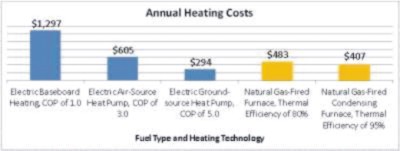
Are You Paying Two to Four Times What You Could be for Your Heating Needs?
We need heat for all sorts of applications including space, water, and process heating. Typically the heating source is provided by either electric resistance or a fuel burner. If given the freedom to choose, would you want heat produced by electric or natural gas? Which option costs less to operate? As engineers like to respond, “It depends.” Several of the important dependent factors are the fuel cost and the heating technology, so let’s take a look, but first a few basics.


Electric and Gas Efficiency Nomenclature
Efficiency by definition is output (heat) divided by input (fuel), and for heating this is typically a percentage. See equation.
Electric heating efficiency is most commonly measured with coefficient of performance or COP. Electric resistance heating has a COP of approximately 1.0; that is for every one unit of electric BTU[i] that is put into it, one unit of heat BTU is produced. An air-source heat pump is more efficient than electric resistance and has a design COP of roughly 3.0, but below certain outside temperatures the air-source heat pump has a COP of 1.0. A ground-source heat pump operates in a similar way but can have a rated COP above 5.0.
The performance of natural gas forced air heating such as residential furnaces and commercial packaged equipment is rated with thermal efficiency. Thermal efficiency is the amount of usable heat energy that is delivered, divided by the amount of fuel energy that is supplied. Most new natural gas furnaces or other packaged heating equipment have a thermal efficiency of at least 80%. A condensing furnace may reach thermal efficiencies of over 95%!
The Most Basic Case
Let’s say a small apartment has a heating load of about 20,000 BTUs per hour during the coldest day of winter. The heat load is the amount of heat required to heat the space. Let’s also assume that the heating system will operate at full capacity approximately 2,200 hours per year in a northern climate. How will various heating fuels and efficiencies stack up to do the exact same job, holding the heat load and hours constant? Based on a fuel cost of $0.10 per kWh for electric and $0.88 per therm for natural gas[ii], see the Annual Heating Costs chart!
The electric baseboard heating costs almost three times as much as the 80% natural gas-fired furnace. Over the 10-year life of the electric baseboard heaters, that’s over $8,000 down the drain for this small apartment! If you were designing the heating system for this space or just choosing a new replacement appliance, which fuel would you chose? There can be other considerations to think about when selecting a fuel type: the capital equipment costs for the fuel-using equipment, ancillary energy costs for delivering heating such as fans and pumps, available fuels and service location, renewable energy options, and, of course, utility rates. With that said, many times it’s just a simple matter of choice!
[i] BTUs are British Thermal Units and are equal the amount of heat necessary to raise one pound of water, one degree Fahrenheit.
[ii] An average of national commercial, industrial, and residential rates from 2010 EIA electric and natural gas data



